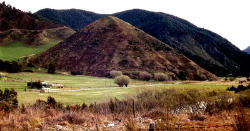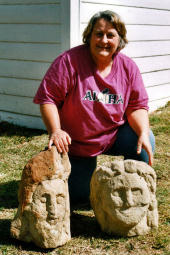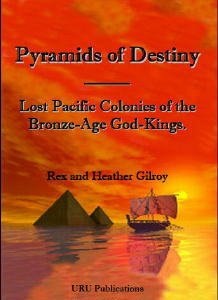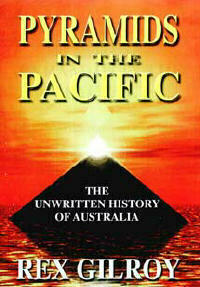
| Pyramids of Destiny – Lost Pacific Colonies of the Bronze-Age God-Kings |
 |
Heather Gilroy , with 3,000 year old stone heads of the Phoenician Sun-God Baal with Phrygian cap, and Earth-Mother Goddess Tanith, found by a Hawkesbury River farmer at Richmond, New South Wales in 1974.
|
Pyramids of Destiny – Lost Pacific Colonies of the Bronze-Age God-Kings
by Rex & Heather Gilroy
Copyright
© Rex Gilroy 2009
| “Australian history is almost always picturesque; indeed it is so curious and strange, that it is itself the chiefest novelty the country has to offer, and so it pushes all other novelties into second and third place. It does not read like history but like the most beautiful lies. Mark Twain: Following the Equator [1891] |
”Every truth passes through three stages before it is recognised. In the first, it is ridiculed. In the second, it is opposed. In the third, it is regarded as self evident.” Arthur Schopenhauer [1788-1860] |
Part Four.
Lost Mining Kingdoms of New South Wales.
Chapter Twenty Five.
Lost Egypto-Phoenician Mines of the Joadja Valley.“I watched the coppersmith at work at the mouth of his furnace.
His fingers were like crocodiles’ claws.
He stank worse than fish offal.
The weaver in the workshop is worse off than a woman,
having to crouch with his knees against his chest,
so that he cannot breathe. If he shirks his day’s weaving he is
beaten with fifty lashes. He has to bribe the doorkeeper
with food, to let him see the light of day”.Written by an unknown trainee scribe
during the New Kingdom of Egypt.
1554-1080 BC.The above text gives us a glimpse into the past, of the daily lives of workers in ancient Egypt, it was probably not much different for the colonists of Egypt’s Australian mining empire. Scribes would have received training in the schools established here, as would weavers, carpenters, those skilled at medicine, mathematics, surveying, astronomy, navigation and ship-building, there would have been schools also for metallurgists who also received training in the field.
The ancients were far from ‘primitive’ in their development of basic skills and the early sciences generally.
It is certain that such schools existed in all the major centres of the Australian kingdoms, and also those beyond these shores, such as in New Zealand.The first colonists to venture up the Hawkesbury River into the Windsor-Richmond district found excellent soil for crop-growing on a grand scale. Their farms would in time spread southward along the Nepean River into the Penrith and Mulgoa district, from where they settled the Camden and Campbelltown area as will be seen.
I have already described the Egyptian adze blade discovered by my late father Mr W.F. [Bill] Gilroy, above Lapstone Gorge in March 1969 [see chapter 23], yet there are a number of other important finds made on the Hawkesbury-Nepean Rivers that leave little doubt that peoples from the land of the Nile and their allies establish settlements along the banks of these rivers and also inland.
In 1974 Mr Mark Farrell, a farmer, was bulldozing a dam for his cattle. At a point 3-4 km inland from the present course of the Hawkesbury in what had in ancient times been an inlet, at a depth of about 2m his machine ploughed up two large lumps of sandstone. Later, while piling rocks to one side of the excavation, he discovered to his amazement that the two large specimens in question were actually carved human heads.
Mark kept the heads as garden ornaments for the next few years, until one day having learnt of our researches, he phoned Heather and I kindly offering to donate the relics to my natural science museum. Excitedly we arrived at mark’s property. Upon seeing the heads for the first time, we were amazed at what we saw. One head, the tallest of the two, was that of a male with an unmistakable Phrygian cap, while the smaller, that of a female, had wavy hair, and the engraving of a fish on the back of the head.
Their identities were unmistakable. The male was undoubtedly Baal, the Phoenician Sun-God, and the female head that of Tannit, their Earth-Mother Goddess. The fish being one of her symbols. The heads had been cut from local rock. Mark felt at the time of his discovery that other sandstone blocks he had gouged out of the earth might have formed a platform upon which these heads had rested. Perhaps the heads were the centrepiece of a farmer’s shrine, where offerings for a good harvest would have been left.
The heads, which now rest in our collection, are to us indisputable evidence of ancient Middle-East colonisation of this region. A bronze arrow head was dug up in a St Marys garden by a woman in 1968, suggesting the ancient settlers had penetrated what is now the Western Suburbs of Sydney.
We have already seen that among the allies of the Egyptians involved in the establishment of the Be-row-ra kingdom, and in the settlement of the Nepean area in particular, there was a Hittite involvement, as revealed earlier in Chapter Six.
There appears also to have been a very strong Celtic presence hereabouts as well. Evidence of this is in the form of rock engravings, found by Heather and I back in 1974 up a remote sandstone gorge through which runs a creek leading into the Nepean River. At the same site we also uncovered Egypto-Phoenician rock scripts.
For one reason or another it would be many years before we could return here and the location was for a time lost in the dense scrub that covered the area. However, on Wednesday 14th August 2002 we rediscovered the site after much searching, finding that layers of moss had long ago covered the glyphs to camouflage them.
Fighting our way down a steep gorge, we had to negotiate the flooded creek by rock-hopping and then climb up and over more rocks until we reached a long, wide ledge running north-south. It was along this ledge that the carvings were to be found. Back in 1974 we had not noticed the placing of stones at the Egypto-Phoenician glyphs, which we now realised to be the outline of a small temple dedicated to Ra, which we later measured to be 6m in width by 8m length.
On the occasion of our 1974 discovery, one stone here we found bore the Egyptian hieroglyph for a papyrus scroll, meaning “a repository of knowledge”. There were other faded glyphs there which we failed to have a good look at on our 1974 visit, because, at the time the sun was sinking and we had to leave the gully. Now these were revealed in full.
The inscription revealed on this stone read:
“A repository of knowledge of Ra the Sun.
Place offerings here where the Eye of Ra watches
over the land from this place”.The stone is one of four uprights forming the north [low] wall of this enclosure which is open to the south and to its right engraved upon a huge boulder we found Egyptian glyphs stating:
“Ships sail in the sun’s light. Ra the Sun”.
Then further to the right, another large upright stone bore an Egypto-Phoenician inscription that included images of ships, a half moon and other glyphs which we read to mean:
“Ships bring new life to this land*.
Ra’s Eye watches over the land here at this enclosure
where the sun’s course and the Moon’s phases are measured”.
[*new settlers]There is a low boulder wall on the temple’s west side but no glyphs are to be found in it.
Nearby, engraved into a vertical rockface we found this curious Celtic ogham inscription:“Ham the Elder declares that Lew is the son
of Gavin and Mab. This is to be observed”.Nearby we came upon a ruined enclosure formed of huge sandstone rocks flanking the disintegrating sandstone floor. To one side of the right wall formed by a massive stone I found a large ‘V’ engraved upon a sandstone slab, being the Celto-Phoenician letter ‘G’ for “Gabba”, meaning “Assemble here”. There were other glyphs carved upon a small slab at the base of the left wall.
Above this slab was another inscription engraved into the massive rock forming the left wall. These were Celtic glyphs with a phallic meaning, as were others clustered around a 1m length by 40cm width and 48cm deep hollow formed on the vertical face of the right wall stone. There was once a wide opening here, an entrance perhaps to an anti-chamber, but in the course of centuries both stones have moved closer together, so that it is now a tight squeeze to get through for an overweight archaeologist!
It became evident to us that we had discovered an ancient Bronze-Age Celtic sex worship temple ruin.
The glyphs carved about the hole included a phallic image and ogham letterings reading:“Place offerings of mushrooms in here for the God.
Observe the phallus swelling erect to the clouds”.The carved slab included two egg-shaped hollows – possible libation bowls, and the ogham message:
“Observe erections here”.Above this inscription was another engraved upon the left wall rock. Consisting of a phallus and “Eye of Bel” symbol with ogham letters, it translated to read:
See the phallus swell erect from the loins to the clouds”.
In antiquity when the Hawkesbury-Nepean River system had a higher water table than today, this gorge would have had a much wider and deeper creek running through it than today. These small temples had been erected upon a high ledge, which in Bronze-Age times would have acted as a stone wharf against which boats would come to rest while worshipers stepped ashore.
Subsequent visits here have, upon our study of the rocks forming the “repository of knowledge” Temple of Ra, shown there to have been a chamber behind this stone, but it has long ago been partly buried by collapsing rocks. The settlers of this region were farmers, so that the Moon’s phases would have been important to people in the planting and harvesting of crops. Many of the farmers were Egyptians judging from the references to Ra, while others were Celts. The Celts, as we have seen, joined the Phoenicians around 1500 BC on voyages to Australia, and as the Hittite stone reported in Chapter Six shows there were apparently Hittite colonists joining in as well. The search is now on to uncover further evidence of Hittite settlement hereabouts.
Main Book Index | Mysterious Australia Homepage | URU Homepage | Australian Yowie Research Centre

